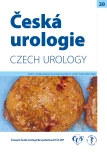OPEN RESECTION OF PAPILLARY RENAL CELL CARCINOMA CATEGORY cT2a
Authors:
Kristýna Procházková 1; Milan Hora 1; Viktor Eret 1; Petr Stránský 1; Tomáš Ürge 1; Tomáš Pitra 1; Petr Hošek 4; Jiří Ferda 2; Ondřej Hes 3
Authors‘ workplace:
Urologická klinika, LF UK a FN Plzeň
1; Klinika zobrazovacích metod, LF UK a FN Plzeň
2; Šiklův ústav patologie, LF UK a FN Plzeň
3; Biomedicínské centrum, LF UK Plzeň
4
Published in:
Ces Urol 2016; 20(3): 192-194
Category:
Video
Overview
Introduction:
Papillary renal cell carcinoma (pRCC) is the second most common renal tumour. The tumour has a characteristic appearance on preoperative CT/MR imaging, with typical extrarenal growth and a regular, cyst imitate (category Bosniak IIF–III), spherical shape (1, 2, 3, 4). These characteristics are most pronounced in pRCC type 1 according to Delahunt (5). This type of tumour also has the best prognosis in this group of tumours. Resection of the tumour is unambiguously the preferred method in these cases. In individual cases it is also possible to safely remove a tumour in category cT2 using resection.
Material and methods:
In our department 1629 renal tumours were surgically treated in a period of 9 years (1/2007–1/2016). 148 cases (9.1 %) were pRCCs, of which 100 represented pRCC types 1 (67.6 % of all pRCCs, 6.1 % of all renal tumours), the others were pRCC type 2 (14/148 – 95 %), oncocytic pRCC – (opRCC (19–12.8 %) and not otherwise specified (NOS) – (15–10.1 %). Oncocytic pRCC has not yet been officially recognized by WHO classification 2016 .
Results:
The preferred method in all groups of pRCC was resection – in pRCC type 1 up to 80.7 %. For comparison, the ratio of resections performed during this period of 9 years (1629 tumours) was 48.4 %. WHO (ISUP) Grade 1 was most represented in pRCC type 1. In other groups, Grade 3 was the most common grade – in pRCC type 2 up to 78.6 %. 3-years progression-free survival was 97.1 % in our study, in pRCC type 2 (44,1 %), opRCC (85,4 %), NOS (69,9 %) (4). The disease progression was observed in 3 patients with a histologically verified pRCC1. All 3 patients had undergone an open nephrectomy. In 2 of the cases due to large tumours, 145 and 180mm (stage cT2b and cT3a) and in one case a tumour duplicity had been diagnosed (tumour of the sigma). In histologically verified pRCC2, a cytoreductive operation was performed in 2 cases of progression. In 3 further cases we noted progression; of which 2 were after resection and one after nephrectomy.
Our video presentation presents a 44years-old, obese man (BMI 30.8) with a palpable renal tumour at the lower pole of the left kidney. Tumour size was 10 cm at the tumour´s widest part according to CT. The tumour has extrarenal growth, regular spherical shape, stage cT2a. R.E.N.A.L. score 9a (6). Translumbal resection was performed, time of clamping of the hilum 7 minutes and blood loss 100 ml. The tissue sample was ochre coloured, typically fragile, 639 g and histologically it was verified as a pRCC type 2, without interference anywhere in the resection line. The patient is so far without recurrence of the kidney tumour (period of monitoring – 32.4 months), but unfortunately he is being treated for metastatic prostatic cancer.
Conclusion:
Papillary renal cell carcinoma is possible in most cases safely treated by resection thanks to its typical extrarenal growth, in individual cases also in stage cT2a. It is necessary to closely monitor patients after resection with histologically verified pRCC type 2 tumours for their proven higher potential of malignancy.
KEY WORDS :
Grade, papillary renal cell carcinoma, obesity, prognosis, resection.
Sources
1. Hora M, Hes O, Boudová L, et al. Papilární renální karcinom. Ces Urol 2002; 6: 26–31.
2. Hora M, Hes O, Klečka J, et al. Rupture of papillary renal cell carcinoma. Scand J Urol Nephrol 2004; 38: 481–484.
3. Delahunt B, Eble JN, McCredie MRE, Bethwaite PB, Stewart JH, Bilous AM. Morphologic typing of papillary renal cell carcinoma: Comparison of growth kinetics and patient survival in 66 cases. Hum Pathol
2001; 32: 590–595.
4. Procházková K, Staehler M, Travníček I, et al. Morphological Characterization of Papillary Renal Cell Carcinoma Type 1, the Efficiency of its Surgical Treatment. Urol Inter 2016 in print, DOI: 10.1159/000448434
5. Delahunt B, Eble JN. Papillary renal cell carcinoma: a clinicopathologic and immunohistochemical study of 105 tumors. Mod Pathol Off J U S Can Acad Pathol Inc 1997; 10: 537–544.
6. Kutikov A, Uzzo RG. The R.E.N.A.L. Nephrometry Score: A Comprehensive Standardized System for Quantitating Renal Tumor Size, Location and Depth. J Urol 2009; 182: 844–853.
Labels
Paediatric urologist Nephrology UrologyArticle was published in
Czech Urology

2016 Issue 3
Most read in this issue
- CYSTIC TUMORS OF THE KIDNEY
- A KNOWN (AND UNKOWN) HIV-POSITIVE PATIENT IN CLINICAL UROLOGICAL PRACTICE
- CABAZITAXEL FOR THE TREATMENT OF METASTATIC CASTRATION-RESISTANT PROSTATE CANCER
- LAPAROSCOPIC NEPHROPEXY
